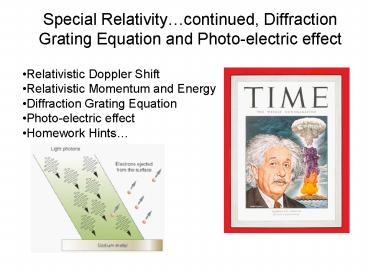Special Relativity - PowerPoint PPT Presentation
1 / 26
Title:
Special Relativity
Description:
Special Relativity continued, Diffraction Grating Equation and Photo-electric effect Relativistic Doppler Shift Relativistic Momentum and Energy – PowerPoint PPT presentation
Number of Views:180
Avg rating:3.0/5.0
Title: Special Relativity
1
Special Relativitycontinued, Diffraction Grating
Equation and Photo-electric effect
- Relativistic Doppler Shift
- Relativistic Momentum and Energy
- Diffraction Grating Equation
- Photo-electric effect
- Homework Hints
2
Relativistic Doppler Shift
- Doppler Shift for Sound, vsspeed of sound
- vrradial velocity of source
- Relativistic Doppler Shift
- Time Dilation
- Varying distance
For ?0? or 180?, then
Transverse Doppler Shift ?90?
3
Relativistic Doppler ShiftRedshift/Blueshift
parameter z
(radial motion)
(radial motion)
Measure redshift ? Measure recession velocity!!!
4
Relativistic Doppler ShiftRedshift/Blueshift
5
Relativistic Velocity Transformations
6
Relativistic Headlight Effectexample 4.3.3
7
Relativistic Momentum and Energy
Momentum
Kinetic Energy
Total Energy
Rest Energy
Momentum Energy Relation
8
Relativistic Momentum and EnergyThe Derivation
of Emc2
9
Relativistic Momentum and EnergyThe Derivation
of Emc2
10
Relativistic Momentum and Energy
Newtonian Mechanics breaks down at high speed
v--gtc. does not hold.
However does still hold if the
momentum becomes.
Derivation pages 105-106
11
Four-Vectors
- Space-time four-vector
Energy-Momentum four-vector
Invariant length
Invariant length
Lorentz Transformation
Lorentz Transformation
12
Spectral LinesApplication of Spectral
Measurements
- Stellar Doppler Shift
- Galactic Doppler Shifts
- Quasar Doppler Shifts
13
Radial Velocities
14
Spectral LinesSpectrographs
- Spectroscopy
- Diffraction grating equation
- (n0,1,2,)
- n order
- Resolving Power
15
Photoelectric Effect
- Classical Expectations
- Kinetic energy of ejected electrons should depend
on strength of electric field and therefore
intensity of light and not the number of ejected
electrons. - Maximum kinetic energy of ejected electrons
should not depend on frequency of light. - Any frequency light should be capable of ejecting
electrons. - Observations
- Kinetic energy of ejected electrons does not
depend on intensity of light! - Increasing intensity will produce more ejected
electrons. - Maximum kinetic energy of ejected electrons
depends on frequency of light. - Frequency must exceed cutoff frequency before any
electrons are ejected
16
Photoelectric Effect
Einstein took Plancks assumption of quantized
energy of EM waves seriously. Light consisted of
massless photons whose energy was Einstein was
awarded the Nobel Prize in 1921 for his work on
the photo-electric effect
17
Photo-electric Effect
18
(No Transcript)
19
Inertial reference frameRemember that the clocks
are located at every point in space
20
Example 4.3.2 useful
21
(No Transcript)
22
(No Transcript)
23
Time DilationLight Clock
24
Worked Problems
25
Worked Problem
26
(No Transcript)































